36 revolting retro recipes EVERYONE used to love
The retro dishes that haunt us
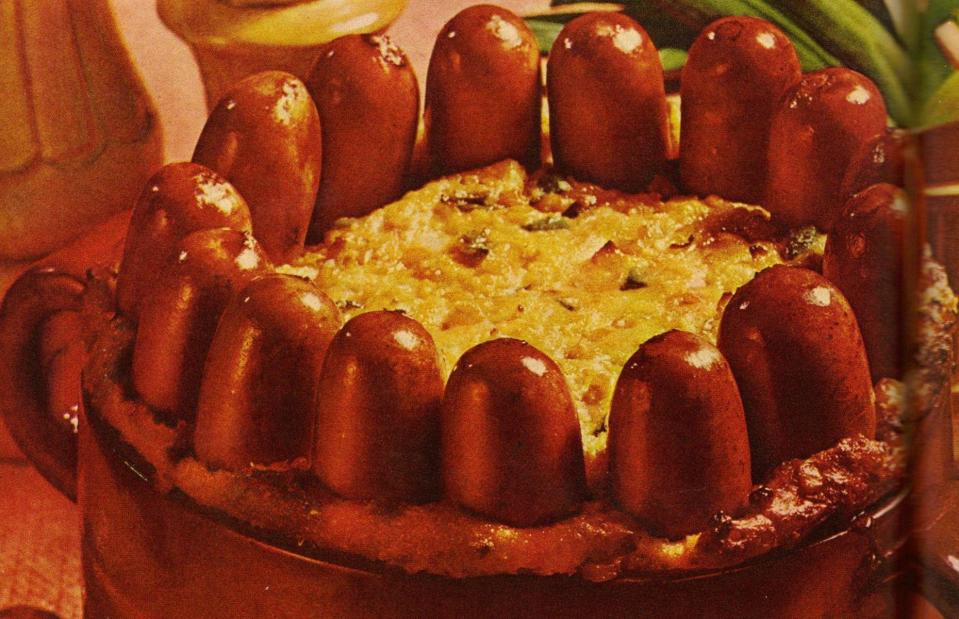
Jamie/Flickr/CC BY-NC 2.0
Some of the all-time great foods have been passed down by generations, but there are some dishes that should stay firmly in the past. We're talking about the sickly retro casseroles and multi-coloured ‘salads’ from your grandma’s vintage cookbooks and the uncanny promotional recipes that featured a plentiful supply of Spam, Jell-O and Cool Whip – sometimes in the same dish. Processed food was king, and showy presentation was a given. Here, we take a look at some of the food nightmares we just can’t forget…
Read on to see the nightmarish retro recipes we wish we could unsee – would you eat any of these today?
7-Layer Casserole
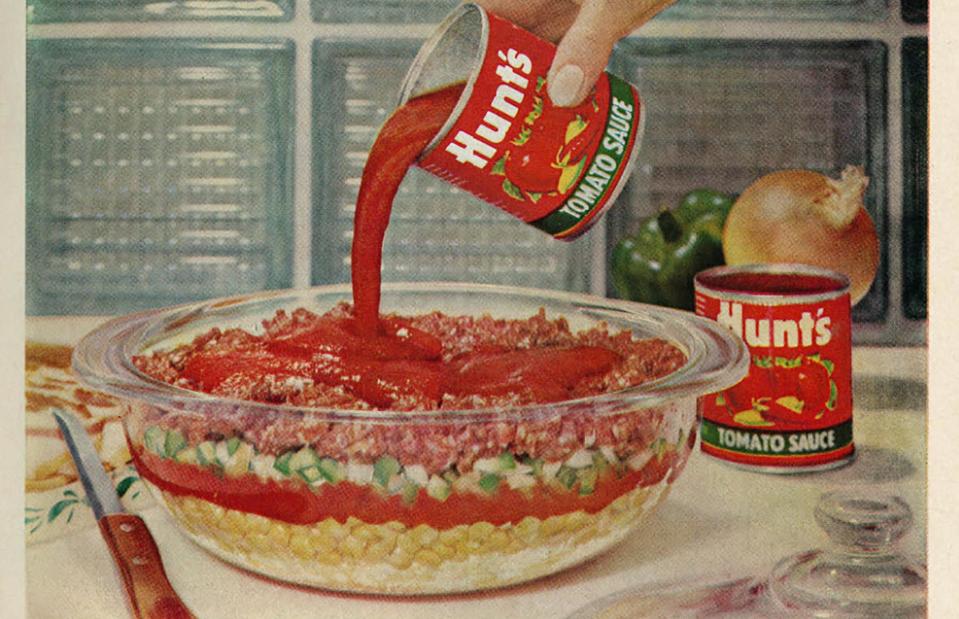
Classic Film/Flickr/CC BY-NC 2.0
This 7-Layer Casserole published in Good Housekeeping in 1958 may be neat and presentable in the picture – but just imagine it after everyone at the buffet table has stuck a fork in. Uncooked rice is topped with sweetcorn, Hunt’s Tomato Sauce, seasoning, chopped onion, green pepper, raw beef mince (ground beef), a second tin of tomato sauce and bacon, and baked in the oven.
Pepped-up beef hash

Classic Film/Flickr/CC BY-NC 2.0
Looking for a way to make corned beef hash more 'appetising'? Simply serve it stuffed and baked in a parboiled pepper. The finishing touch is a squeeze of catsup or ketchup, and a little horseradish. It probably tasted OK, if you're a fan of a breakfast hash – but the presentation means it looks more like something you'd feed to your dog or cat.
Green Beans Gretel
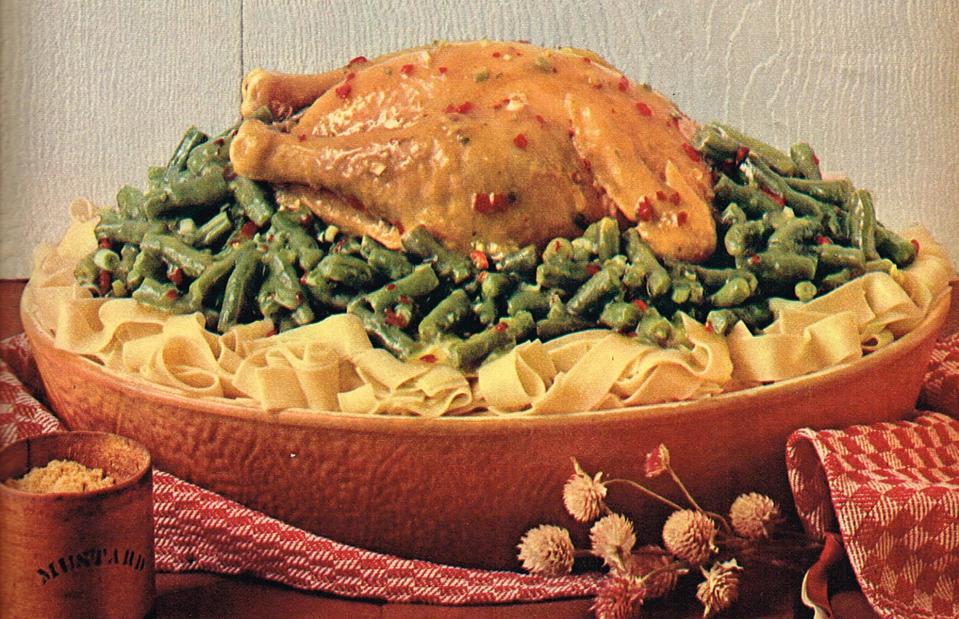
Jamie/Flickr/CC BY-NC 2.0
An old-country feast, Green Beans Gretel was published as a recipe in Family Circle in 1963. Del Monte green beans are cooked in butter, onion, pimento, horseradish and mustard, and served with chicken and noodles. So far, so good. But the presentation with the whole roast chicken on top? It’s a little barbaric and probably makes carving and serving difficult, too.
Spam Brittany

Classic Film/Flickr/CC BY-NC 2.0
In 1960s America, Spam was pretty much guaranteed to make regular appearances at the dinner table, having soared in popularity during the Second World War. This recipe for Spam Brittany, published in Woman’s Day in 1967, jazzes it up by alternating meat slices with apple, giving it an orange marmalade glaze and clove studs.
Spam Country Dinner

Classic Film/Flickr/CC BY-NC 2.0
These may look like the three worst Spam dinners of all time, but in 1958 food manufacturer Hormel Foods posed the big question: 'Which Spam dinner is top winner?' This lot came out on top. Spam Country Dinner (egg noodles, chicken soup, Spam and vegetables) seized the top spot, followed by 6-in-1 Supper Bake (a Spam, macaroni, mushroom soup and vegetables casserole) and Spam ‘N’ Rice Ring (a rice, Spam and soup bundt filled with vegetables). Oh, how far we’ve come in the past 60 years.
Coleslaw in a cabbage

Classic Film/Flickr/CC BY-NC 2.0
Presentation is everything when it comes to getting people to eat questionable coleslaw, and no decades knew this better than the 1960s and 1970s. This advert, published in Woman’s Day in 1966, showcases how seafood coleslaw can be made to look like the centre of a flower – and proves that cottage cheese coleslaw works well in geometric shapes.
Hot dog plate
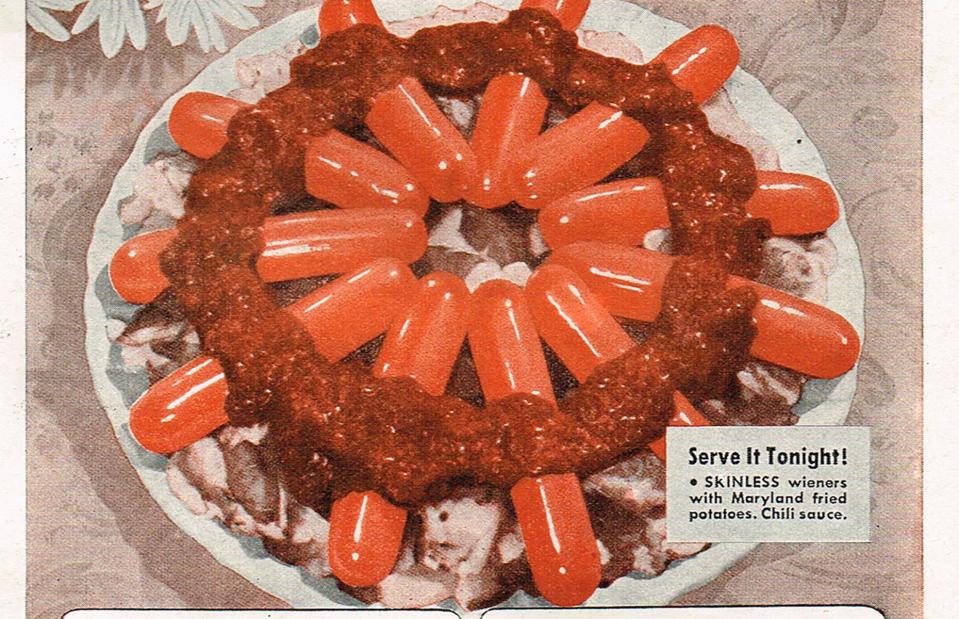
Jamie/Flickr/CC BY-NC 2.0
This alarming hot dog plate was seen in a 1942 McCall's magazine feature, urging readers to try out a new type of skinless frankfurter. It describes them as tender and nourishing, urging home cooks to serve them with fried potatoes and chilli sauce. The presentation here is, as always, key.
Sack O' Sauce in a Can O' Meat
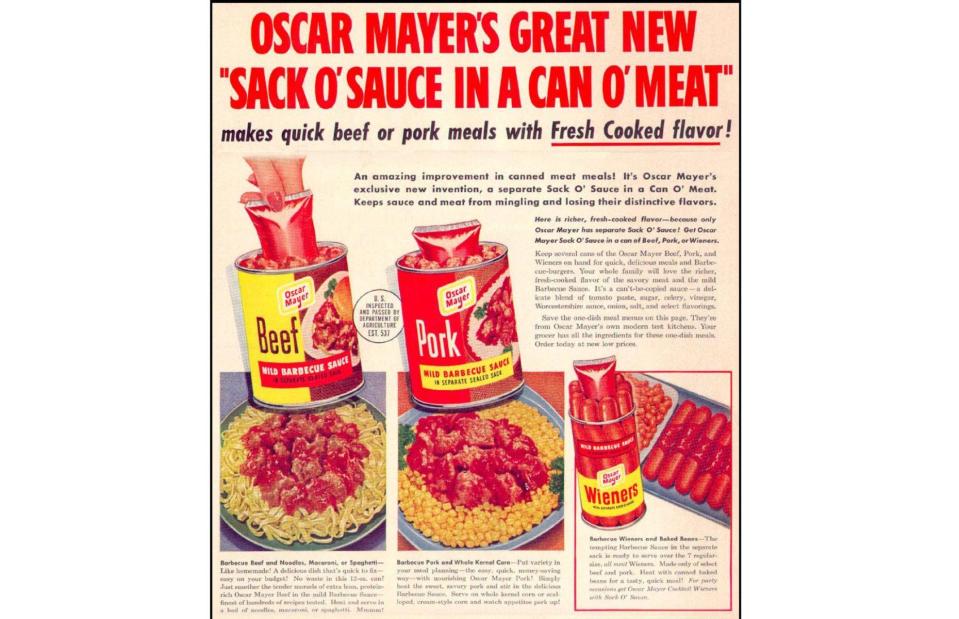
Mark Murrmann/Flickr/CC BY 2.0 DEED
Looking for a way to pep up your Can O' Meat? Why not add a Sack O' Sauce? The name of this product, shown here in a 1950s Oscar Mayer ad, really says it all. Admittedly, the product being advertised is pretty novel – canned meat sold with a separate bag of sauce to mix in before serving, in order to keep the ‘sauce and meat from mingling and losing their distinctive flavors'. Unsurprisingly, the product didn’t hang around for long.
Skillet risotto with Velveeta
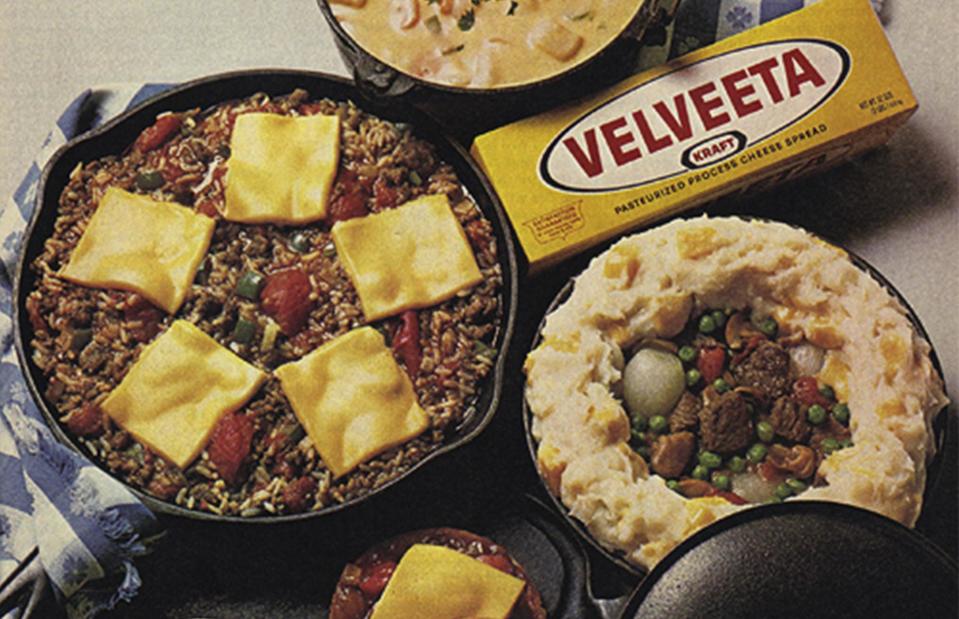
Jamie/Flickr/CC BY 2.0
In the 1970s, the idea of an appetising supper was something along the lines of this rice and beef mince skillet, with squares of Velveeta processed cheese patchworked on top. It's described as 'convenient, wholesome, economical and delicious' – we're not so sure about that.
Fruit mayonnaise with roast chicken
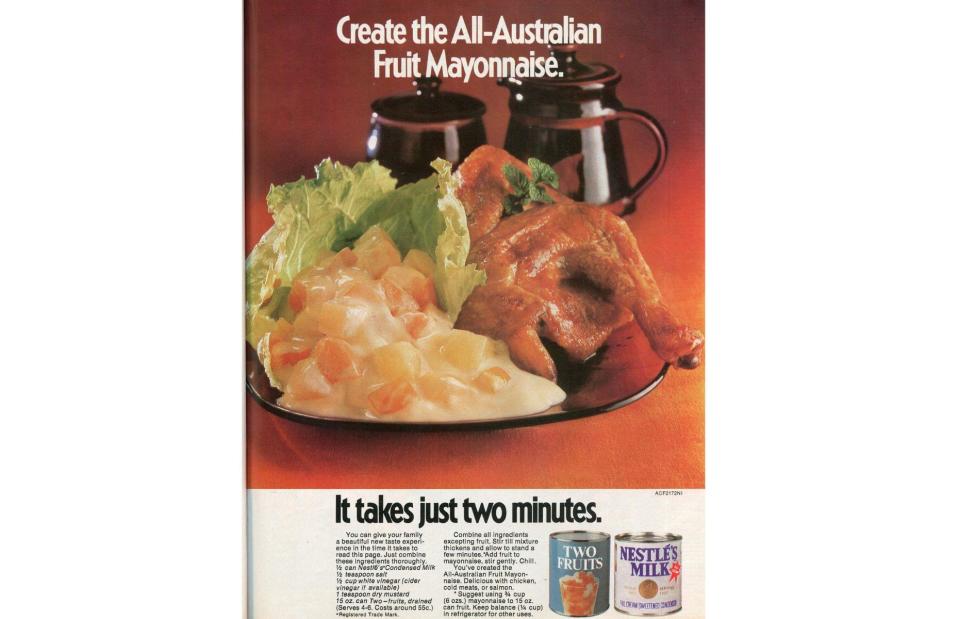
Internet Archive/Public Domain
Mayonnaise was the star ingredient of many culinary experiments from the 1970s, and Australian diners certainly weren’t spared the ordeal of eating horrors like this – shown in the 1973 edition of women’s magazine New Idea. Combining Nestlé Condensed Milk and canned fruit to make an ‘All Australian Fruit Mayonnaise’, the end result is supposed to be served with roast chicken, cold meats or salmon. The uncanny presentation, with the overflowing mayo salad on a plate with what looks like an entire roast chicken, doesn’t help matters.
Mett-hog

Q77photo/Shutterstock
There’s nothing to see here – just a cute little hedgehog moulded from raw meat. In its basic form, the German dish known as hackepeter (or mett) is raw minced pork seasoned with salt and pepper and spread generously over bread or toast. However, when given the 1970s treatment, the rustic dish is formed into a mound and lovingly decorated with onions and gherkins to look like a sweet little hedgehog. Between the 1950s-70s this bizarre creation was often the centrepiece of German birthday parties or cold buffets. We’ll stick to the crisps and dip.
Lime Jell-O in a pineapple can

James Vaughan/CC BY-NC-SA 2.0 DEED
The 1970s were awash with crimes against (and committed by) Jell-O, with everything from sausages to whole fish encased in the wobbly lime-flavoured stuff. This grisly looking recipe was a common serving suggestion from tinned fruit brands like Dole at the time, and the one thing it has going for it is simplicity; to make it, you just drain the juice from a pineapple tin, add Jell-O and let it set. It may not be the most sophisticated dish, but compared to the horrors of the time, it probably didn’t taste that bad.
Campbell's chicken chow mein

Internet Archive/Public Domain
Nothing says ‘authentic Chinese food’ like a can of Campbell’s Chicken Soup. This advertisement for a pretty bland-sounding version of chicken chow mein promises a ‘taste of the exotic’ but we can’t see how adding a whole tin of soup to a stir fry can create anything other than a soggy bowl of noodles. The recipe featured in a 1984 edition of Toronto’s TV Guide – the ad even suggests eating it before heading off to an evening course in Chinese brush painting – and it highlights the explosion in popularity of Chinese-Canadian cuisine in the 1980s
South American Salad
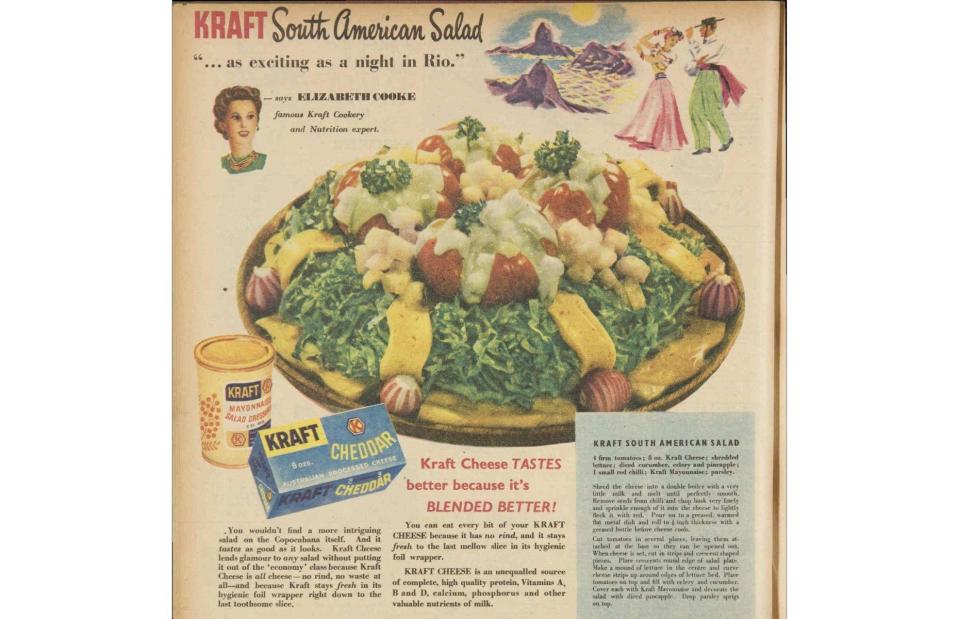
Internet Archive/Public Domain
Here's yet another ‘exotic’ recipe that sounds (and looks) anything but. In fact, the only ingredients bringing excitement to this fairly basic salad of Kraft cheese, tomatoes, lettuce and cucumber is the pineapple and chopped red chilli – not exactly ‘as exciting a night in Rio’, as the tagline promises. Then again, the ad is taken from an issue of Australian Women’s Weekly from 1949, so we’ll let it pass.
Ham and bananas Hollandaise
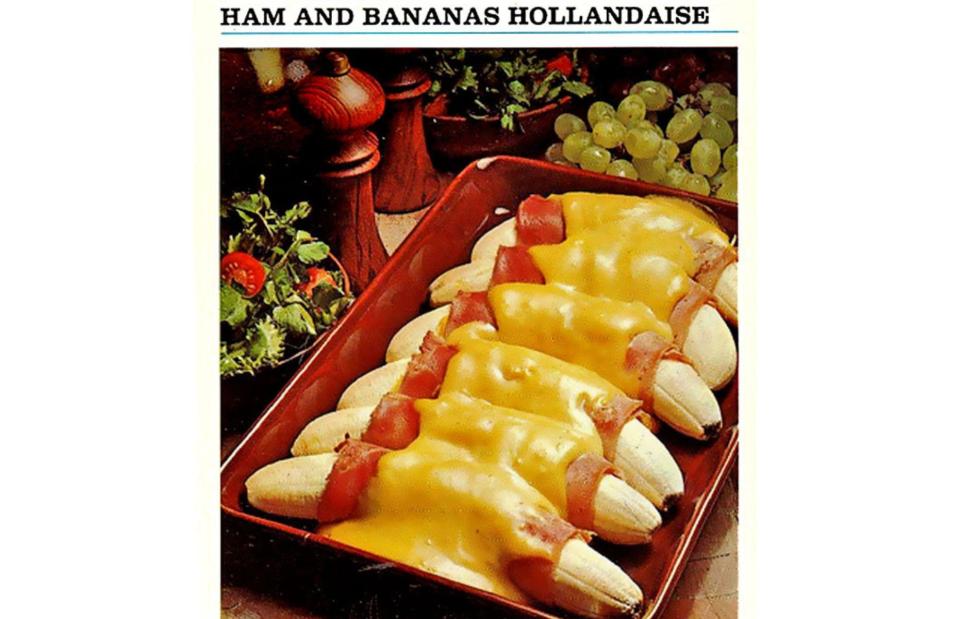
James Vaughan/CC BY-NC-SA 2.0 DEED
This monstrous creation would certainly be a talking point at brunch. Taken from McCall’s Great American Recipe Card Collection from 1973, this bizarre riff on eggs Benedict sees a row of helpless bananas wrapped in ham, smothered with a buttery Hollandaise sauce and baked in a casserole dish until golden. How do you serve such a creation? It's ‘nice with a green salad for brunch or lunch', according to the recipe.
Pretty pickle tower
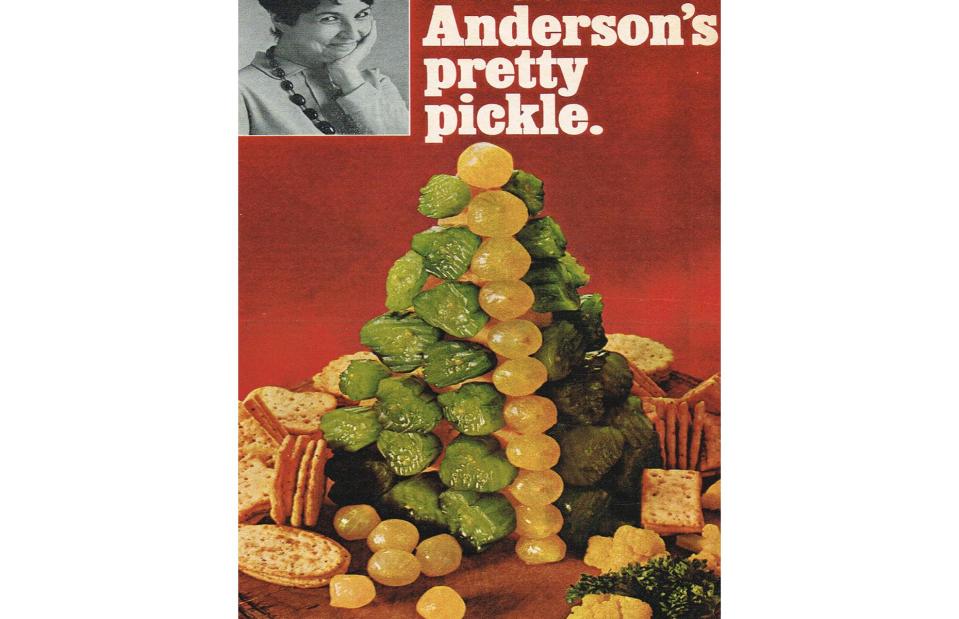
Jamie/Flickr/CC BY-NC 2.0
A table decoration that’s functional and filling, this recipe for Alice Anderson’s pretty pickle tree was published in Chatelaine magazine in December 1967. If you're wondering how to make it – and even if you aren’t – it’s a wedge of cheese with the base trimmed so it stands upright, with Heinz pickle slices and pickled onions studded into it with toothpicks.
Spaghetti meatball sundae
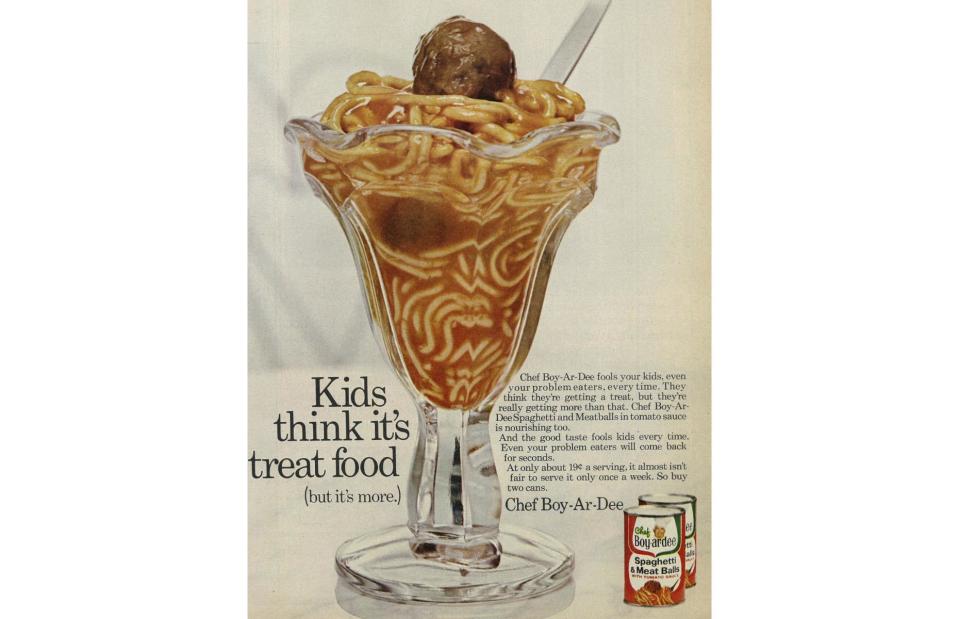
Classic Film/Flickr/CC BY-NC 2.0
A savoury dish that looks like a sweet treat isn’t likely to fly with kids today, but Chef Boy-Ar-Dee was pretty proud of this illusion. It insisted that children would love it and it was nourishing, too. Either tinned spaghetti and meatballs has massively deteriorated in quality since the 1970s, or this advert is overselling itself.
Tomatoes filled with tinned minced steak
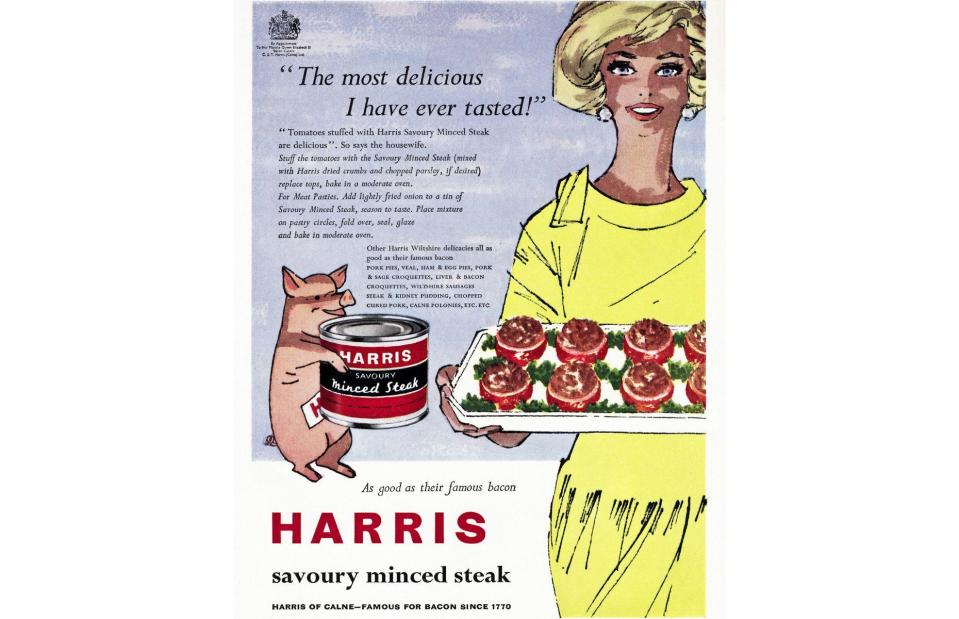
Hera Vintage Ads/Alamy Stock Photo
You might imagine a 1950s British dinner party to be a sophisticated affair with strong cocktails and delicate canapés – and nothing says chic like a hollowed-out tomato filled with tinned beef mince. That's according to this 1958 ad from historic British meat producer Harris of Calne, anyway. The recipe calls for the meaty mixture to be baked inside tomatoes until they’re soft, making for a pretty messy meal.
Curry in a Hurry
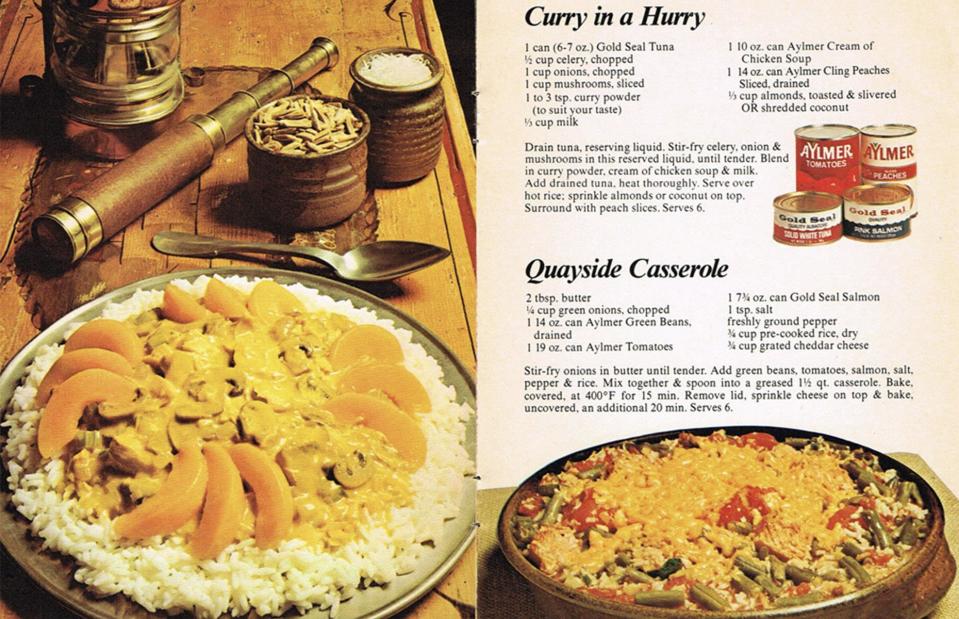
Jamie/Flickr/CC BY-NC 2.0
In a rush? Take a shortcut to your favourite curry with a couple of quick tricks from Aylmer and Gold Seal canned foods, as detailed in this 1970s recipe. All you need is tuna, cream of chicken soup, peach slices, mushrooms, onions, curry powder, almonds – and, we imagine, a stomach of steel.
Campbell’s meatloaf three ways

Jamie/Flickr/CC BY 2.0
In the late 1960s, Campbell’s suggested three (pretty terrifying) new ways to present meatloaf. Home cooks were encouraged to try it frosted with mashed potatoes and a drizzle of mushroom soup, shaped into a giant meatball to serve over spaghetti with tomato soup and – perhaps the most horrifying – shaped like a bundt cake and glazed with cheese soup. This vintage advert was published in Good Housekeeping in 1969.
Sussex pond pudding
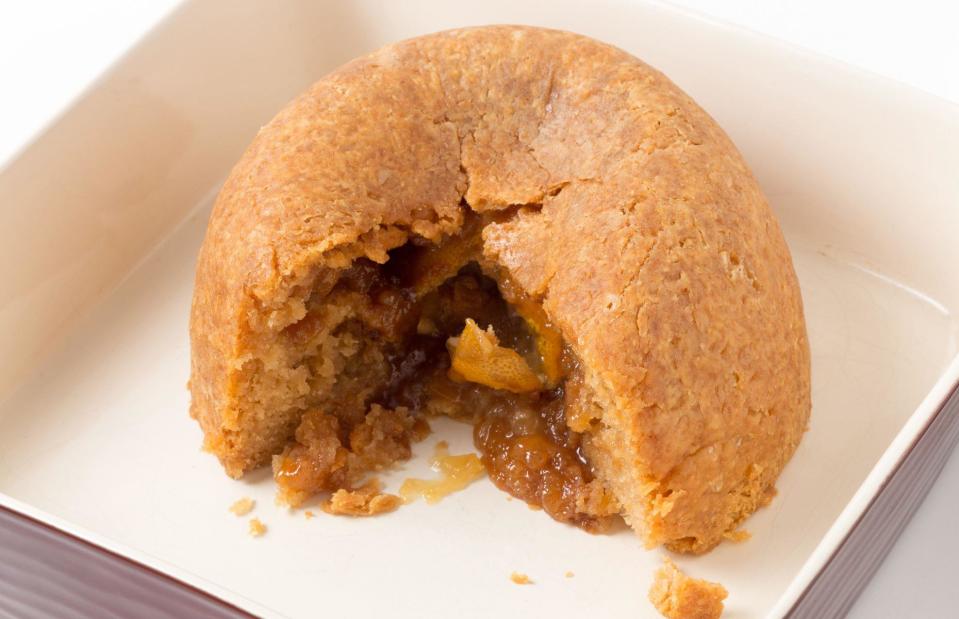
Paul Cowan/Shutterstock
Traditional British steamed puddings are a labour of love that require hours to cook but are usually worth the wait…unless you’re talking about Sussex pond pudding, that is. The name admittedly doesn't help, but the combination of a whole lemon steamed for several hours inside crusty steamed pastry made from suet (a hard white animal fat usually taken from beef) just isn’t worth the effort, in our opinion. It dates back to the 1600s and was revived briefly in the 2000s, as part of an effort to bring back historic British foods.
Spaghettieis
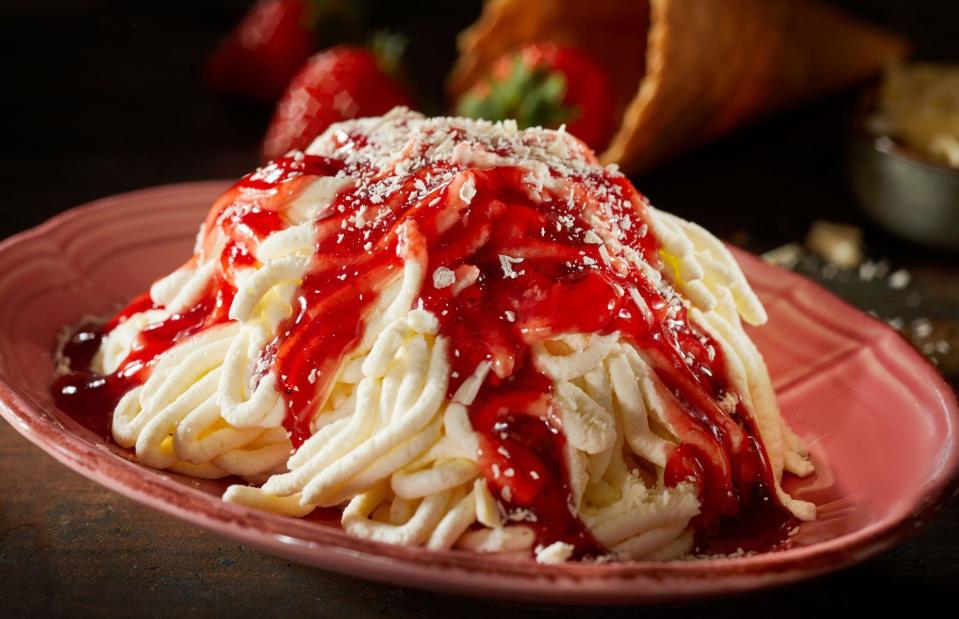
stockcreations/Shutterstock
At first glance, there’s nothing especially unusual about this tasty pile of spaghetti, covered with tomato sauce and dusted with grated cheese. On closer inspection, though, you’ll notice it doesn’t look quite right – the sauce has a sticky, jam-like quality and those pasta strands are starting to melt. The dish is actually spaghettieis, an ice cream sundae invented in 1960s Germany – and currently enjoying something of a revival. Combining vanilla ice cream, strawberry sauce and white chocolate shavings, it tastes pretty great, but we can’t quite get over the uncanny presentation.
Veg-All tuna casserole

Classic Film/Flickr/CC BY-NC 2.0
Tuna noodle casserole was a massive hit in the 1950s, as it was cheap and easy to feed the family. However, this Veg-All Tuna Casserole, made with tinned mixed vegetables, tuna, chopped onion, Worcestershire sauce, breadcrumbs and cheese, takes things a step too far. Published as a recipe idea in 1953, doesn't have any pasta in it and has ketchup squirted on top.
Veg-All Pie Plate Salad
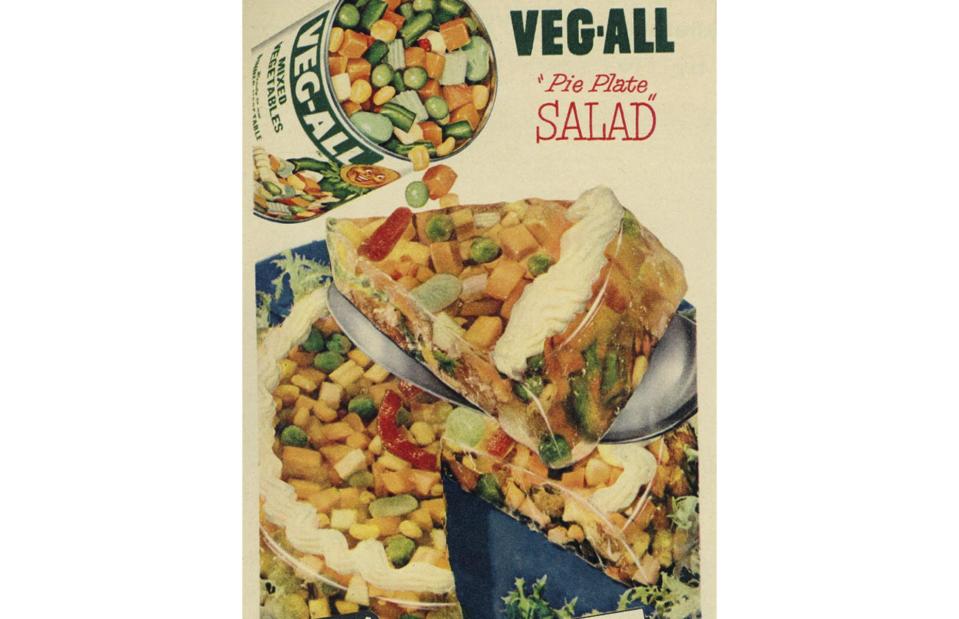
Classic Film/Flickr/CC BY-NC 2.0
Retro canned food brand Veg-All also gifted us with this Pie Plate Salad. In this recipe, tinned vegetables are added to lemon gelatine, set in a mould, sliced like a pie and garnished with tartare sauce. Only a couple of slices and you’ll have reached your five-a-day.
Surprise! mayonnaise mould

Jamie/Flickr/CC BY-NC 2.0
Surprise! This mayonnaise mould from the 1970s was the height of impressive hosting in its day. Looking like the result of hours of work in the kitchen, it actually comes from a recipe box that shows you exactly what ingredients to use. A masterful meal or masterful marketing from Knox? You decide.
Souper sandwiches
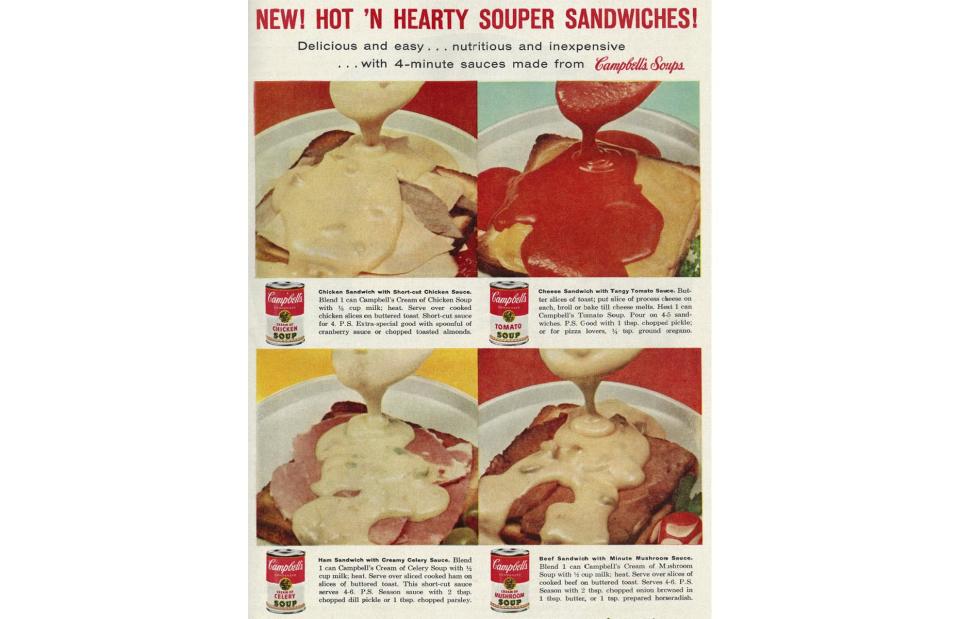
Classic Film/Flickr/CC BY-NC 2.0
In the 1950s, Campbell’s convinced us that sandwiches could be made hot and hearty by substituting the top slice of bread for sauce made from tinned soup. It suggests chicken soup for a chicken sandwich, tangy tomato soup for cheese, creamy celery on ham, and mushroom soup for beef. The advert isn't really selling it for us...
Jell-O salad
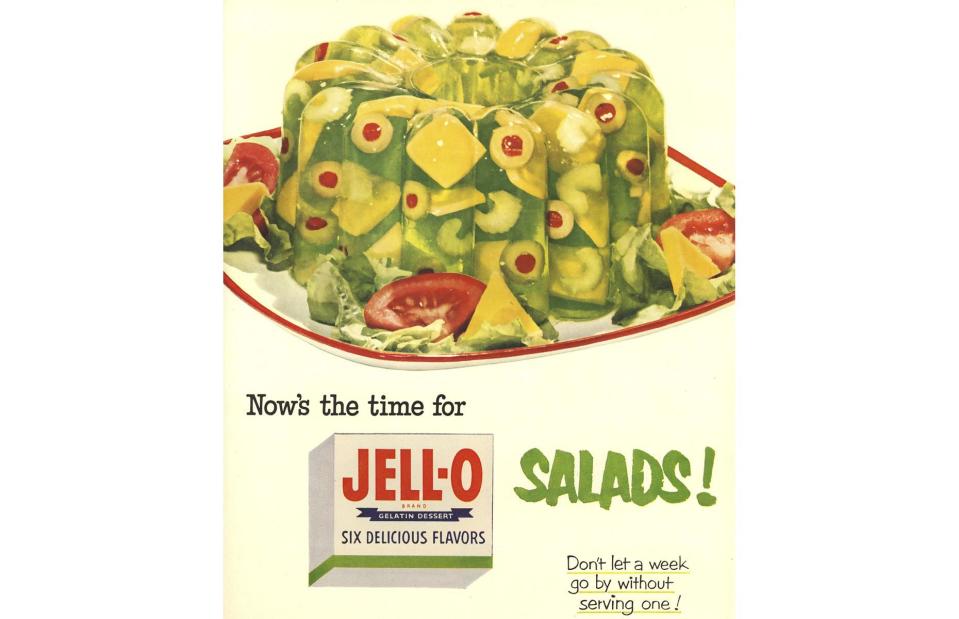
James Vaughan/Flickr/CC BY-NC-SA 2.0
Somehow, for the best part of a century, Jell-O convinced America it was a necessary ingredient in salad. Yet miraculously, we survive without it now. It came in six flavours, but a popular one was lime, displayed in this vintage advert featuring pieces of olives, celery and cheese. The advice was don’t let a week go by without serving one – something keen home cooks jumped on.
Watergate salad
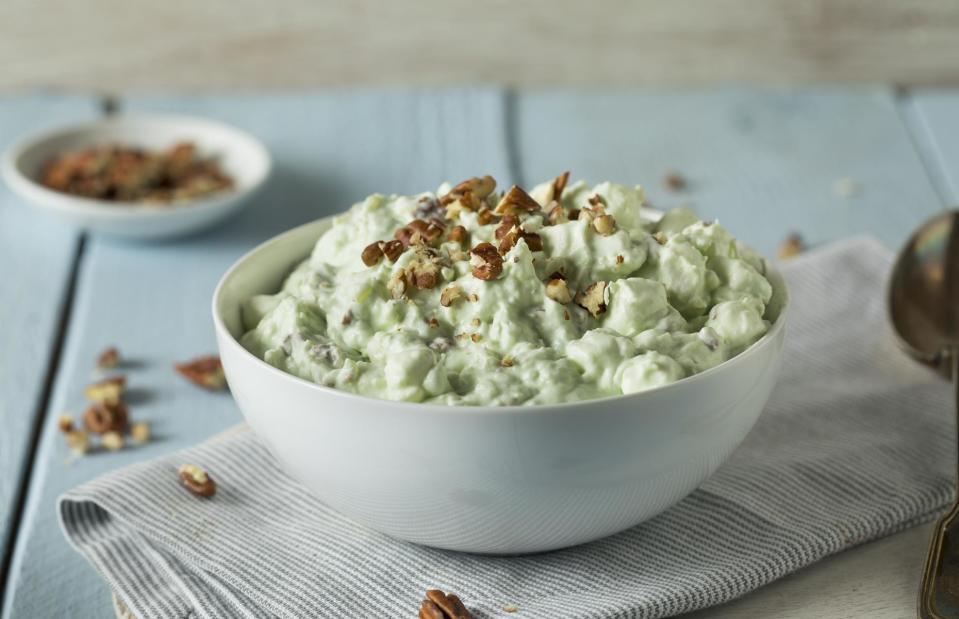
Brent Hofacker/Shutterstock
One dish from the 1970s we wish we could forget is Watergate salad, ambrosia’s green cousin. It consists of tinned pineapple, mini marshmallows, whipped cream, chopped nuts and Kraft pistachio instant pudding mix. And if there’s one thing we’ve learned from it, throwing handfuls of eclectic sweet ingredients into the same bowl and stirring will rarely produce a decent dessert.
Hamburger with a new look
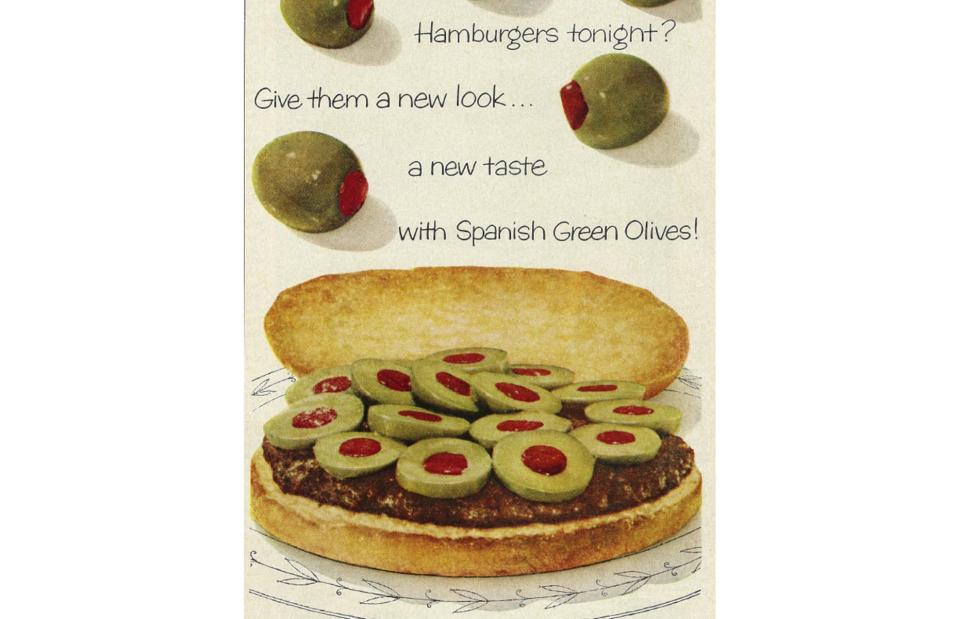
Classic Film/Flickr/CC BY-NC 2.0
Imported Spanish green olives had some serious marketing acumen back in the day and managed to persuade us the salty nibble was a great accompaniment to any dish. We were sticking them on cheese logs, frankfurters and even burgers. We think this hamburger, published in Good Housekeeping in 1958, would’ve been better without them.
Lime pear and olive carrot moulds
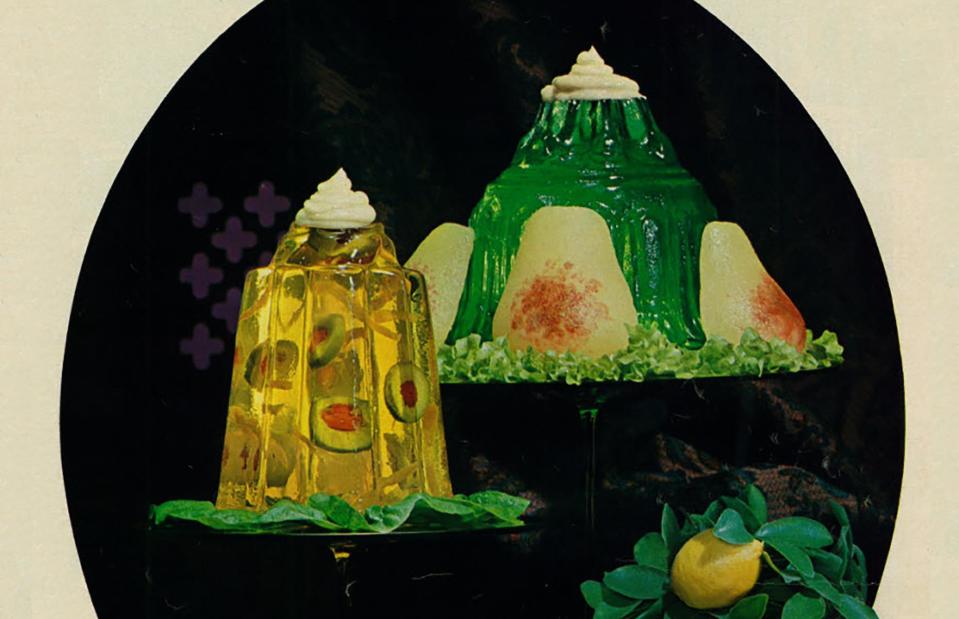
Classic Film/Flickr/CC BY-NC 2.0
Lemon mayonnaise sounds appealing served with tinned pears and lime jelly, right? What about lemon jelly with stuffed olives, grated carrots and the zingy condiment? In 1965, a Kraft Mayonnaise advert in Look magazine wanted us to try these recipes, insisting a touch of lemon juice was just the ticket to perk up flavour.
Cling-a-Ling salad
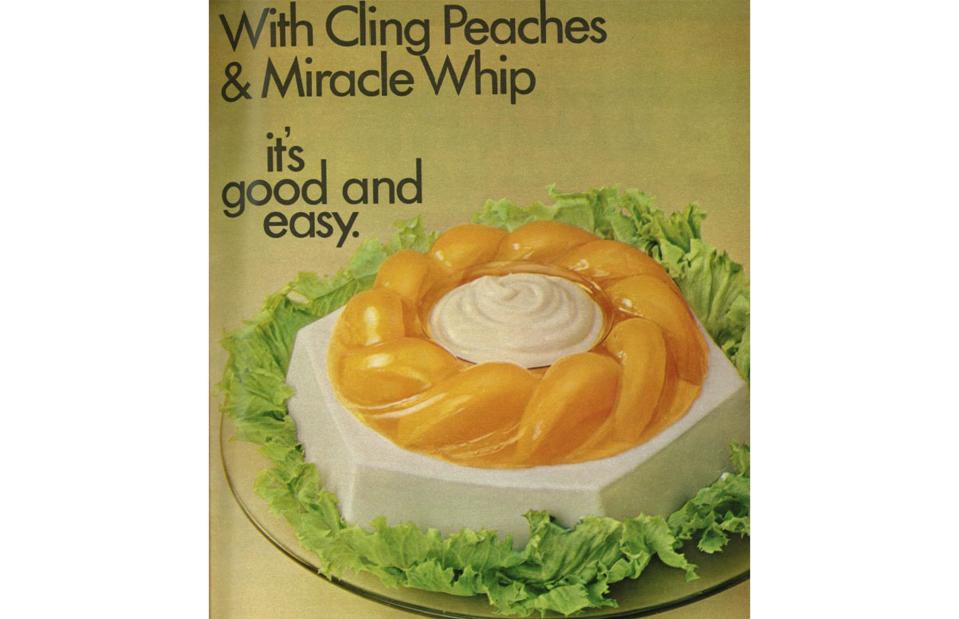
Classic Film/Flickr/CC BY-NC 2.0
With a name like Cling-a-Ling salad, you just know it’s going to be dreadful. This recipe from a 1967 Family Circle is for a double-layer jelly made from Miracle Whip (a mayonnaise alternative), gelatine, instant pudding and cling peaches, all served on a bed of iceberg lettuce.
Creamettes macaroni salad bowl
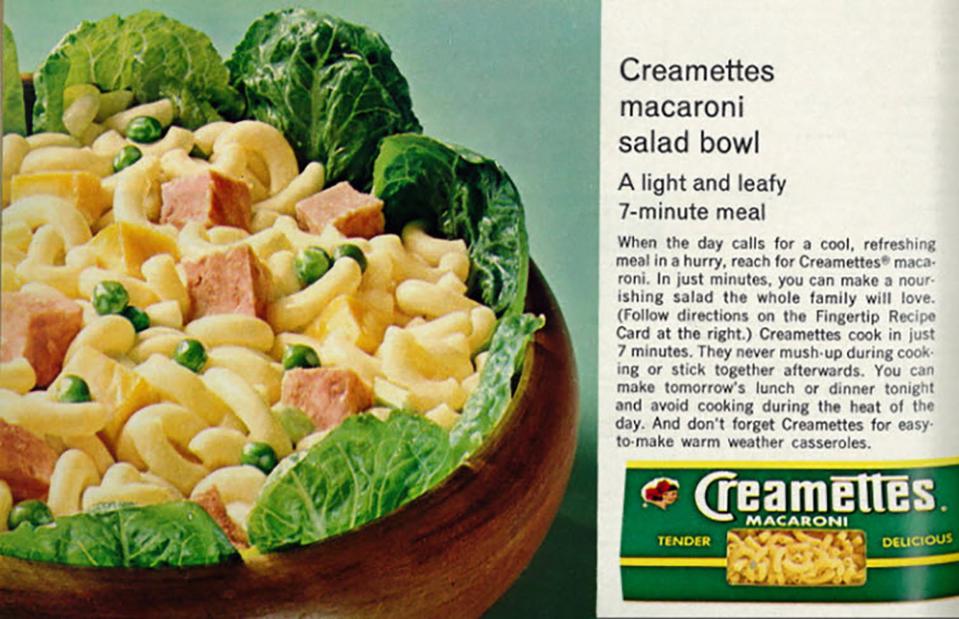
Classic Film/Flickr/CC BY-NC 2.0
Another 1960s salad that can only be loosely defined as such, the Creamettes macaroni salad bowl describes itself as a 'light and leafy 7-minute meal'. With ingredients including diced Spam, salad oil, mayonnaise and Cheddar, we're thinking less light and leafy and more seven-minute mess.
Toast Basket A La King
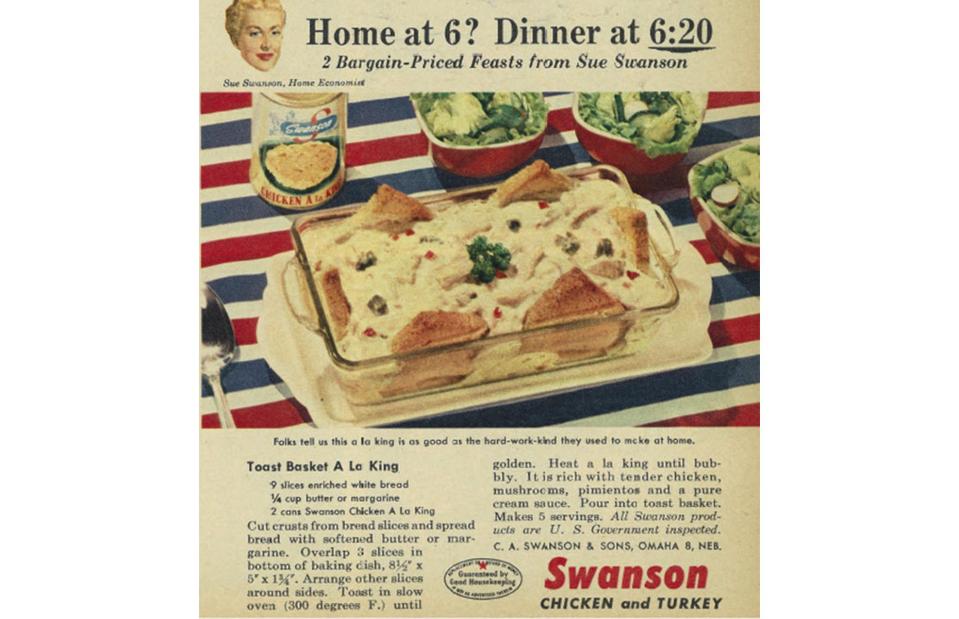
Classic Film/Flickr/CC BY-NC 2.0
This creamy chicken dish was popular throughout the 20th century and a Swanson recipe for it, published in Family Circle in 1953, even received the Good Housekeeping seal of approval. White bread is spread with margarine, baked in the oven and topped with a can of Swanson Chicken à la King. We're not sure a recipe for how to pour tinned food over toast is strictly necessary.
Frank and Corn Crown
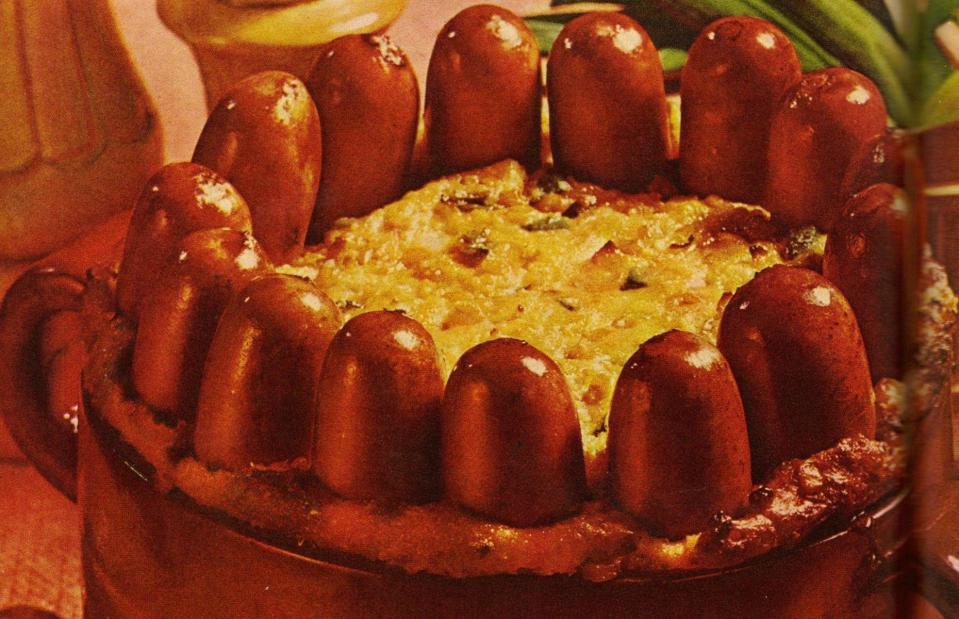
Thoth God of Knowledge/Flickr/CC BY 2.0 DEED
A not-so-regal celebration of canned food in all its glory, this striking recipe features a ‘crown’ of frankfurters stuck into a kind of stuffing, made with creamed corn, peppers, butter, breadcrumbs and egg. It featured in the 1968 edition of the Better Homes and Gardens Meat Cook Book, which is a feast of retro horrors like this.
Souper barbecue sauce

Jamie/Flickr/CC BY-NC 2.0
In a 1957 issue of Ladies Home Journal, Campbell’s suggested its tomato soup mixed with brown sugar, vinegar, Worcestershire sauce, sweet-pickle relish and chopped onion was the perfect accompaniment to any barbecued meat. Just look at it, dripping off those sausages and burgers. Bon appétit!
Patio Platter
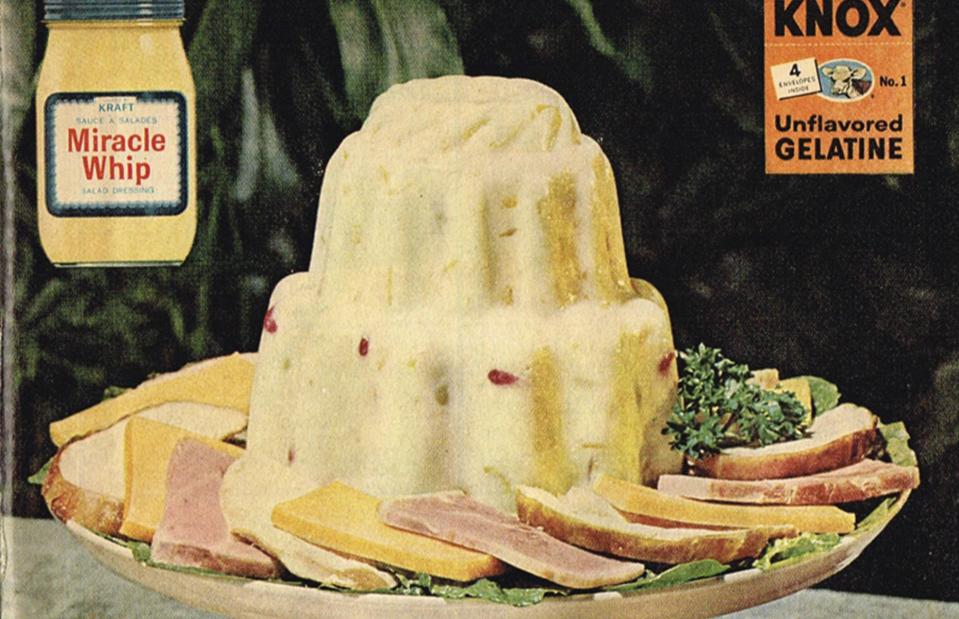
Jamie/Flickr/CC BY-NC 2.0
This Patio Platter from Miracle Whip and Knox, published in Reader’s Digest in 1965, was presented as the perfect party dish. The fruit cocktail and mayonnaise jelly was said to pair perfectly with cold cuts of ham, chicken or turkey and Kraft cheese slices. And no one will ever guess the secret ingredient: frozen lemonade concentrate.
Not all retro foods belong in the past. These are the retro dishes that deserve a comeback


